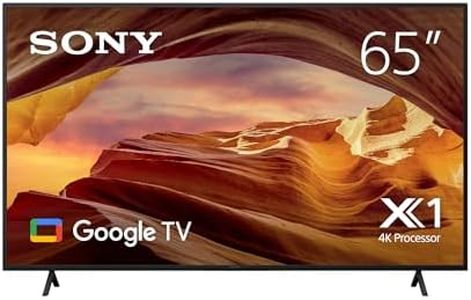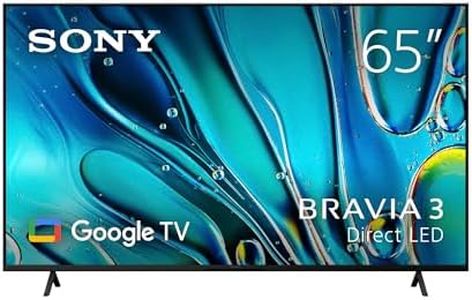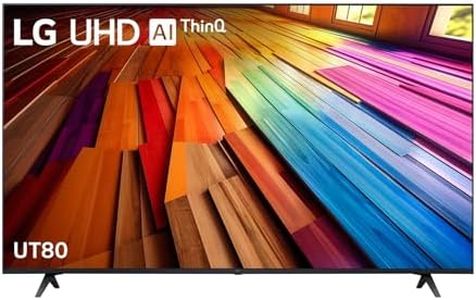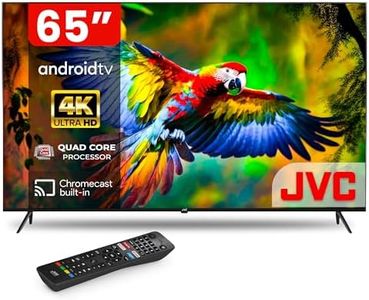We Use CookiesWe use cookies to enhance the security, performance,
functionality and for analytical and promotional activities. By continuing to browse this site you
are agreeing to our privacy policy
10 Best 65 Inch TVs
From leading brands and best sellers available on the web.Buying Guide for the Best 65 Inch TVs
When you're shopping for a 65-inch TV, you're likely looking for an immersive viewing experience that works well in larger rooms or for home theaters. The large screen size can really bring movies, sports, and games to life, but to get the most out of your new TV, it's important to look beyond just size. There are several key features that will affect picture quality, performance, and usability, so understanding what each one means and how it fits your needs will help you make the right choice.ResolutionResolution refers to the number of pixels that create the image on your screen. The most common resolutions for 65-inch TVs are Full HD (1080p), 4K (Ultra HD), and 8K. The higher the resolution, the sharper and more detailed the picture will look. On a large screen like a 65-inch, 4K is usually recommended because it brings a lot of clarity and fine detail, especially when sitting close to the TV. 8K is even sharper, but content that takes advantage of 8K is still limited. If you mostly watch standard TV or older DVDs, Full HD might be enough, but for streaming, gaming, and future-proofing, 4K is the sweet spot for most people.
Panel TypeThe panel type determines how the TV produces color and light. The main types are LED, QLED, and OLED. LED TVs are common and offer good brightness and efficiency. QLED (Quantum Dot) TVs boost color and brightness even more, making them great for bright rooms. OLED TVs give you the deepest blacks and most vibrant colors, excellent for watching movies in the dark and for more realistic pictures. If you watch TV in a bright room, LED or QLED may be better. For serious movie lovers who want top picture quality, OLED is usually the favorite.
Refresh RateRefresh rate measures how many times per second the screen updates the image, shown in Hertz (Hz), like 60Hz or 120Hz. A higher refresh rate means smoother motion, which is especially noticeable in fast-moving content like sports, action movies, or video games. Most TVs have 60Hz or 120Hz. If you mainly watch news, dramas, or sitcoms, 60Hz is usually fine. For sports fans and gamers, 120Hz gives a much better experience with less motion blur.
HDR (High Dynamic Range)HDR is a feature that improves the contrast, brightness, and color range, making images look more realistic and vivid. Not all TVs handle HDR the same way. Some offer basic HDR, while others handle advanced formats like HDR10+ or Dolby Vision, which provide even more impressive visuals. If you stream content from modern platforms or watch UHD Blu-ray discs, HDR support makes a big difference. Pick a TV with strong HDR if you care about getting the most lifelike picture.
Smart TV FeaturesMost 65-inch TVs today offer smart features, which let you stream shows and movies, browse the internet, and download apps without extra devices. Different smart TV systems (like Android TV, webOS, or Tizen) have their own layouts and app choices. The quality of the smart features can affect how easy it is to find and enjoy content. If you want a simple, easy-to-use smart interface, or if you use specific apps, check the TV’s smart platform to see if it fits your habits.
Ports and ConnectivityPorts are where you plug in devices like gaming consoles, soundbars, streaming boxes, or Blu-ray players. Common ports include HDMI, USB, and optical audio. More HDMI ports give you more flexibility. Some newer devices need features like HDMI 2.1 for things like faster gaming or 4K at higher refresh rates. Think about how many and what kinds of devices you plan to connect now and in the future, and make sure the TV has enough of the right ports.
Viewing AngleViewing angle refers to how well the picture looks when you’re sitting off to the side instead of directly in front of the TV. Some TVs keep their colors and brightness better when viewed from an angle, while others look washed out. If you have a wide living room or family members who will be watching from different spots, look for a TV that advertises wide viewing angles to ensure everyone gets a good image.












